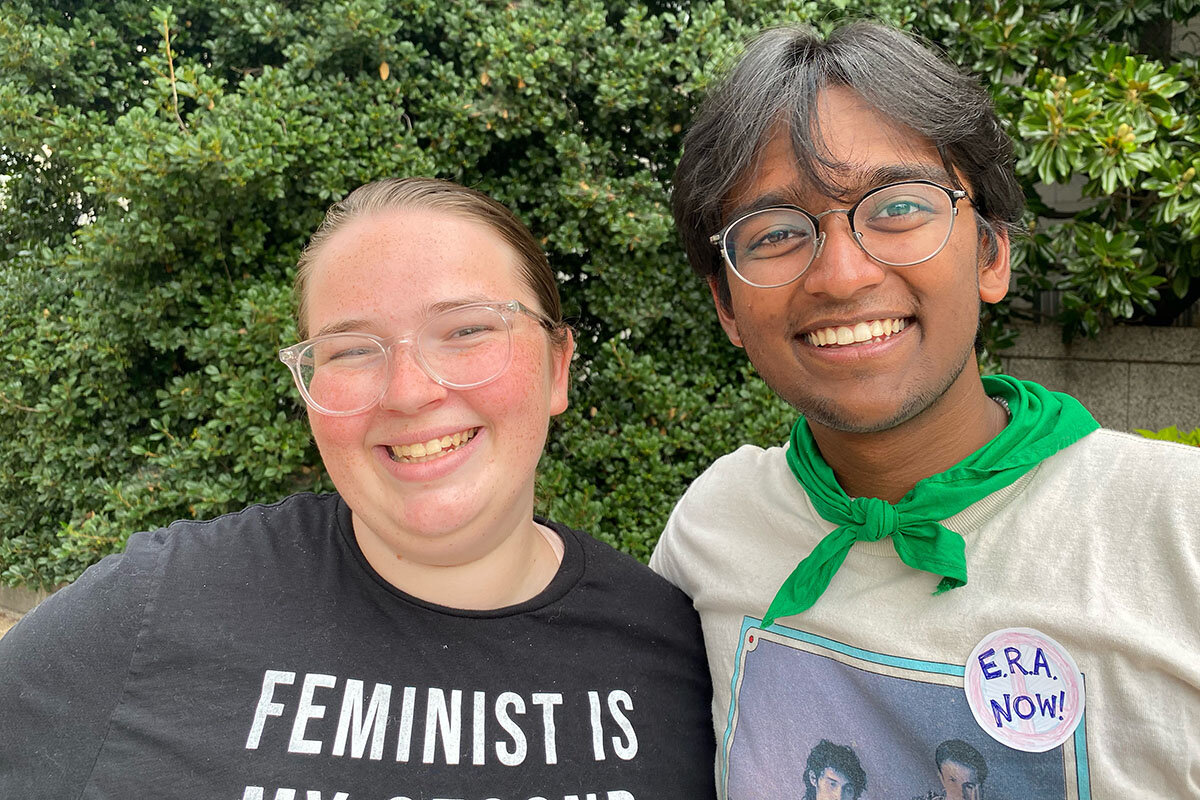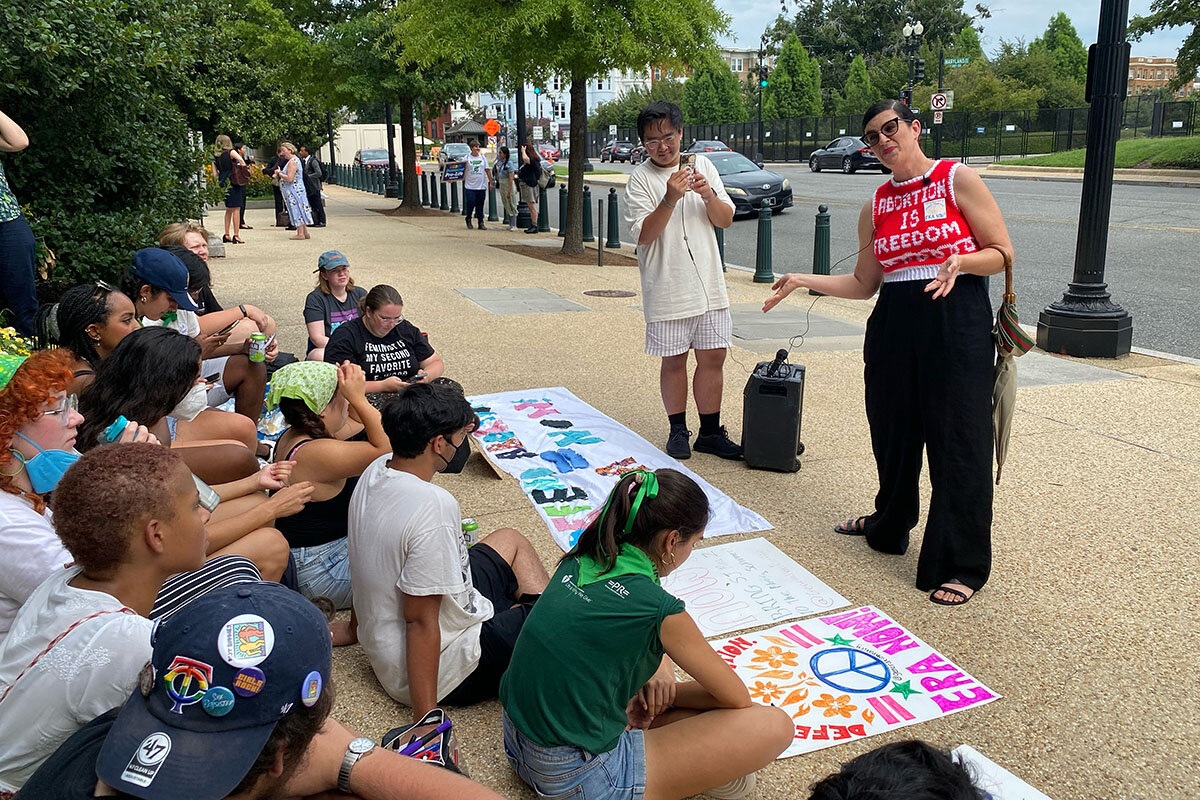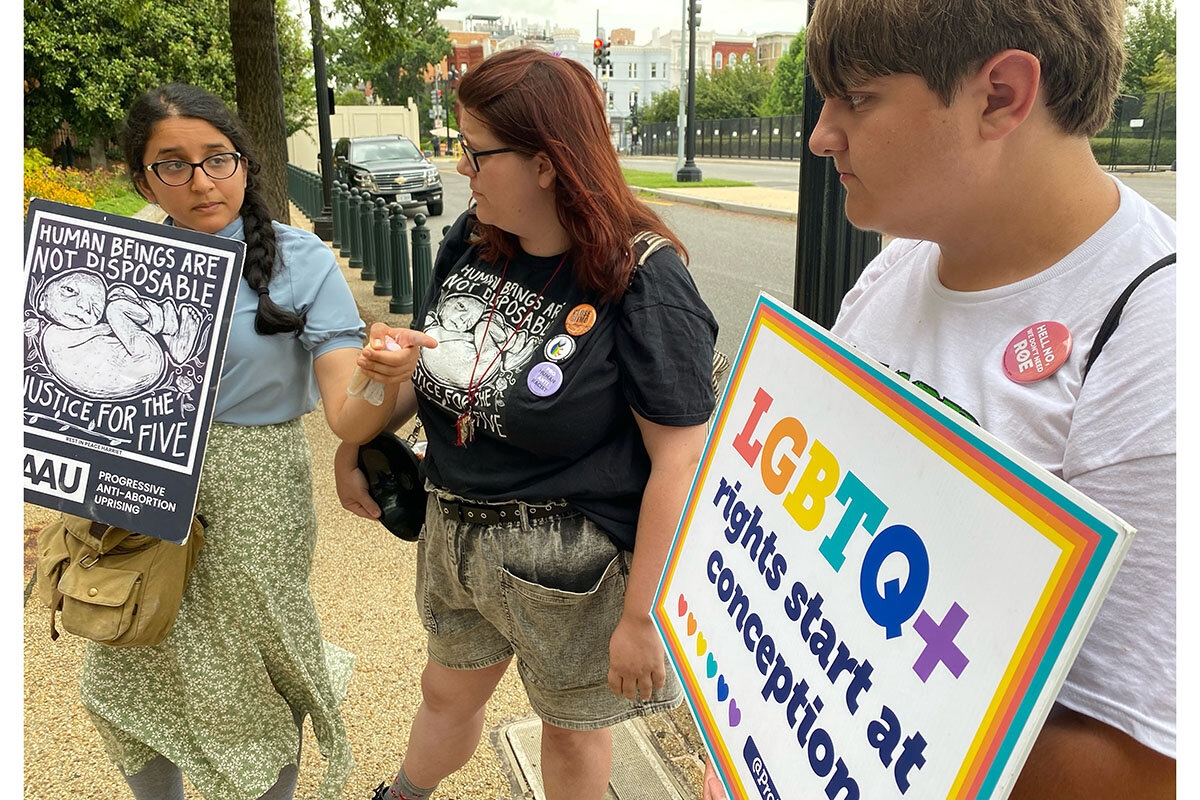Young, impatient, and intersectional: Gen Z activists tackle abortion
Loading...
| Washington
“Thank you, Senator Blumenthal. ... We appreciate you!”
Rosie Couture, shouting like a fangirl at the Connecticut Democrat as he walks by, is set up outside the Hart Senate Office Building on Capitol Hill. It’s a hot summer afternoon, and she’s there with some 15 other teens for a “teach-in” on the Equal Rights Amendment (ERA) – a cause Sen. Richard Blumenthal supports.��
Propped up on the sidewalk, a hand-printed piece of cardboard bears the amendment’s core provision: “Equality of rights under the law shall not be denied or abridged by the United States or by any state on account of sex.”
Why We Wrote This
Many teenage activists see the older generation as failing to meet the moment when it comes to reproductive rights – and more. So they’re fighting in their own way, eschewing traditional groups to start new ones or simply taking action on their own.
Next to it, a sheet is laid out on the sidewalk with the words “Defend Abortion = ERA Now.”����
Ms. Couture, a recent high school graduate from suburban Virginia, believes getting the 1970s-vintage ERA certified as part of the United States Constitution could provide the quickest path to reestablishing a constitutional right to abortion. And in the weeks since the Supreme Court struck down Roe v. Wade, she and her peers have been on a mission to get it done.��
In the legal world, this take on the ERA’s potential to help secure abortion rights, at least anytime soon, is largely seen as a long shot. But these Generation Z activists are undeterred by the skepticism of their elders, whom they see as failing to meet the moment when it comes to reproductive rights – and so much more. Like many of their peers, they’re both convinced of the rightness of their cause and frustrated by what they see as the slower-moving political and organizational powers that be. And so they’re fighting in their own way, eschewing traditional groups to start new ones or simply taking action on their own.��
On many issues, from gun control to climate change, this generation has already demonstrated it can punch above its weight. In Parkland, Florida, survivors of the 2018 mass shooting at Marjory Stoneman Douglas High School turned trauma into action by organizing March for Our Lives, now one of the top gun-safety advocacy groups.��
Young climate activists from the Sunrise Movement made headlines in 2019 when they staged a sit-in at the office of Democratic Sen. Dianne Feinstein of California. Greta Thunberg of Sweden, still a teenager at 19, has been grabbing global attention since 2018 with her calls for climate action.
And on abortion, 19-year-old abortion-rights activist Olivia Julianna of Houston recently , including the actions of a member of Congress, into fundraising gold. So far, she’s raised more than $2 million for the group Gen Z for Change to support abortion access.��
“I’m from Generation X, and I was taught to wait my turn,” says ���Ǵ��� Nunes, president of the National Organization for Women since 2020. “Gen Z and millennials are pushing back on that. And that’s a wonderful thing.”
But even as young activists are praised for bringing fresh faces and ideas to their respective causes, they are criticized for putting idealism ahead of pragmatism. they’ve been accused of being pawns for adults.��
As the dust settles in the wake of Roe’s demise – and as big players like NARAL Pro-Choice America and Planned Parenthood gear up for the battle ahead – young people like Ms. Couture seem likely to serve as both innovators and disrupters, bringing critical energy and people power, as well as some tensions, to the broader movement.��
“The younger generation, Gen-Z in particular, wants organizations to be what they want them to be at any point in time,” says Jennifer Lawless, a political scientist at the University of Virginia in Charlottesville. Often, that means striking out on their own, finding “like-minded people through social media and other outlets,” she says. “It’s just a different way of doing politics.”��
Dawn of the post-Roe era
Ms. Couture learned about the ERA at age 14 and was shocked to discover that equal rights on the basis of sex weren’t already part of the Constitution. In 2019 she co-founded Generation Ratify, working to make Virginia the 38th and final state needed for ratification – a legislative effort that came to fruition in 2020.��
Now, at age 18, she slings the language of her cause like a seasoned Washington lobbyist. She was at the table in early June when the White House convened a on reproductive justice and civil rights. This fall, she’ll be a freshman at Harvard.��
Conservative youth, too, are taking matters into their own hands – from protesting abortion in states where it’s still widely available, to fighting what they call ,” to suing over on college campuses.
But at the dawn of the post-Roe era, the greater urgency is on the left, now driven by a mix of anger and hope. Adults under 30 are by far the most pro-abortion-rights age cohort in the U.S., according to Pew Research Center, with in all or most cases.��
Yet for Gen Zers – those born between 1997 and 2012 – this isn’t their mother’s or grandmother’s feminism.��
Older, liberal women, many of whom remember life before Roe, are more inclined to act by donating to the larger, established abortion-rights organizations and protesting at big rallies, say experts on feminism.��
Among Gen Z, the activism looks more atomized – lots of smaller groups doing their own thing, and exploiting the viral potential of social media, including TikTok and Instagram.��
To be sure, young people are involved in big national organizations, typically through college chapters. Amanda Matos of the Planned Parenthood Action Fund offers examples:����over legislation, since enacted, to ban abortion in the state after 15 weeks of pregnancy; and����to ensure access to medication abortions via campus health centers.
In addition, Ms. Matos says, young people have been engaging in what she calls the “invisible work” of educating and mobilizing their communities around abortion access.
Young people “may or may not show up in a rally or march, but their work shows direct impact,” says Ms. Matos, senior director of the organization’s constituency campaigns.
“Intersectionality” – the intertwining of race, class, and gender identities – is often a key component. Gen Z is the most diverse age cohort in American history: Only a bare majority are non-Hispanic white, and 21%��of those who have reached adulthood��, according to a 2021 Gallup poll.��
“That’s important, because lived experiences have an impact on how you show up in your activism,” says Kimberly Inez McGuire, executive director of Unite for Reproductive & Gender Equity, or URGE, which she describes as an “intersectional reproductive justice organization” with a youth focus.
That emphasis on intersectionality has also generated controversy. Some progressives have replaced the phrase “pregnant women” with “pregnant people” to include those of all gender identities capable of becoming pregnant, including transgender men –��a move that has sparked mockery from the right and which even some abortion-rights advocates say may alienate potential allies.
The linguistic debate doesn’t divide neatly along generational lines, but it’s one more example of how an internal disconnect can bog down the abortion-rights movement when it can least afford it.��
Still, it’s the tension between young reproductive-rights activists and old-school feminists that remains paramount. At an abortion-rights rally in Washington in mid-May, quickly organized after the draft decision overturning Roe leaked, the crowd of several thousand skewed older. Paradoxically, the women most directly affected by curtailed abortion rights – those in their prime childbearing years – were underrepresented.��
Professor Lawless, who studies the politics of gender, says she noticed back in January 2017, around the massive women’s march on the Washington Mall, that the younger generation seemed put off by the idea that there was an organizing entity.
Ask Ms. Couture of Generation Ratify about this, and the frustration pours out.��
“National women’s groups that are led by adults just tend to not effectively reach young people,” the 18-year-old says. “There’s some kind of lost-in-translation thing about how important young people are to their strategy.”��
Taking it to the White House
On a recent Saturday, a dozen members of Generation Ratify staged an “overnight action” in Lafayette Park across from the White House. They brought sleeping bags, snacks, and big light-up letters spelling “ERA now” to display along the fence on Pennsylvania Avenue.
The gathering seems as much slumber party as direct action. Seated in a circle, participants introduce themselves, including preferred pronouns. The goal, Ms. Couture says, is to tell President Joe Biden that “we’re not going to sleep until he fights for equality.”��
Frustration with President Biden has been a running theme among abortion-rights activists – and not just younger ones – since Roe was overturned on June 24. Critics say his administration didn’t appear to have an action plan ready to go, even though a draft of the high court ruling had leaked nearly two months earlier.��
Administration officials push back on this characterization, pointing to the , and his two subsequent executive orders aimed at protecting abortion rights – including the right to travel across state lines for the procedure and to access medication for self-induced abortions.��
But activists like Ms. Couture remain unsatisfied. On June 8, she and other youth leaders met with female officials from the president’s Office of Public Engagement and Gender Policy Council and from Vice President Kamala Harris’ office. Despite the high-level attendees, she still sounds dissatisfied.��
“I was like, where’s the Biden people? Are we just gonna pin this on the women?” Ms. Couture says.��
Her youthful idealism and impatience can come across as naive. But her persistence no doubt helps explain why Generation Ratify landed the White House meeting, as well as meetings with staff of some 30 House and Senate members, including aides to New York Sen. Chuck Schumer, the Democratic leader. They’ve also talked to some lawmakers themselves.��
“One of our more interesting interactions was with [Arizona Democratic] Sen. Mark Kelly,” says Ritwik Tati, one of the group’s two national organizing directors and a rising sophomore at Stanford University. “He seemed surprised to hear that we have the required number of states to ratify the ERA.”
Mr. Tati is alluding to the Virginia legislature’s 2020 vote, meaning the ERA now has won support from three-quarters of U.S. states (38), the threshold needed to amend the Constitution. Supporters say Virginia’s ratification put the ERA just one signature away – that of the national archivist – from becoming the 28th Amendment.
Even if that signature were obtained, however, lawsuits would follow. The amendment’s original ratification deadline expired in the 1980s, and five states have since rescinded their ratifications. ��
Moreover, even if the ERA were to be formally adopted, it’s not clear that it would offer a realistic path to restoring a constitutional right to abortion. Kate Kelly, a lawyer who advises Generation Ratify, that “with five dedicated antiabortion ‘originalists’ on the Supreme Court, the only thing we can do to protect abortion rights permanently is to change the constitutional text.”
But many legal scholars doubt that the courts, particularly the U.S. Supreme Court, would regard a constitutional right to equality on the basis of sex as a legitimate underpinning for a guaranteed right to abortion. What’s more, passage of state laws and state constitutional amendments asserting that fetuses are people further complicates the effort.��
Some abortion-rights advocates not affiliated with Generation Ratify say the fight for the ERA is worth having anyway. “I agree that if the ERA is in the Constitution, there could be a future grounding for a new constitutional right to abortion,” says Leila Abolfazli, director of federal reproductive rights at the National Women’s Law Center in Washington.��
It’s just that that future may have to wait for a less conservative generation of judges, she adds.
In January, Mr. Biden to pass a resolution recognizing ratification of the ERA. But his focus clearly lies elsewhere. On the day of Roe’s demise, ��in the November midterm elections, and didn’t mention the ERA. Legislation that Democrats claim would codify Roe has passed the House but not the 50-50 Senate, where 60 votes are needed for passage.
For now, “we’re stuck with a state-by-state situation,” says David Garrow, a historian and expert on reproductive rights. For that reason, he says teen activists like those of Generation Ratify would have a much greater impact if they focused their efforts on “extrapolating from what happened in Kansas.”��
He’s referring to the surprisingly robust victory Aug. 2 by abortion-rights advocates in deep-red Kansas, where voters opted 59% to 41% not to amend the state constitution in a way that could have led to an abortion ban. Democrats hope it’s a sign that young people, notorious for not voting in midterms, will turn out nationwide in November.��
Engaging with all sides
Back at the Hart Senate Office Building, Ms. Couture of Generation Ratify notices three young people standing nearby holding anti-abortion signs, and her face lights up.��
“We have some counterprotesters, now would you look at that!” she says.
“This kid, we know him,” says Mr. Tati. “He’s a gay, pro-life Democrat.”��
His name is Hayden Laye, a teen from Walhalla, South Carolina, and he’s holding a rainbow-colored sign that says “LGBTQ+ rights start at conception.” The other two protesters are from the group Progressive Anti-Abortion Uprising.
A middle-aged adult who’s there to support Generation Ratify wants nothing to do with the counterprotesters. But Ms. Couture engages with them in an animated discussion. They agree to disagree, and everyone is civil. If nothing else, it’s yet more evidence that young people aren’t apathetic – they just do things in their own way.��








